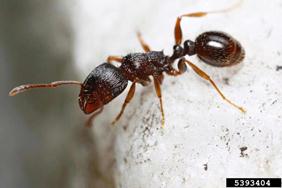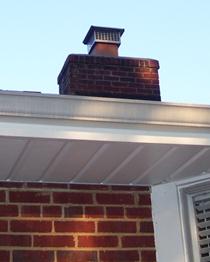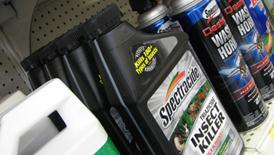Integrated Pest Management (IPM)
Pests can be managed in many different ways. The term integrated pest management or IPM refers to the various management practices associated with resolving pest issues. The EPA describes IPM as an “effective and environmentally sensitive approach to pest management that relies on a combination of common sense practices”. These approaches differ depending on the type of pest or individual pest species and the site where the pest is found. If you were to ask a farmer and a pest management technician (exterminator) to provide a definition of IPM you might get two distinct but similar answers. Each person is dealing with different pest issues in distinct environments. The farmer is managing pests that harm his crops while the exterminator is managing pests in and around homes or buildings.

Source: Joseph Berger, Bugwood.org
Identifying Pests
Before any decisions can be made about how to manage a pest, it first needs to be identified. Some pests which are very similar may require different management practices due to their feeding preferences. Some ants for example prefer sweets while others prefer fats or oils. This preference, in some cases, may change throughout the year. Another example would be the use of certain herbicides to control weeds. Broad leaf herbicides are effective at controlling weeds such as dandelions but may be ineffective at controlling crabgrass.
By identifying a specific pest, a management plan can be developed for the specific pest using one of the four IPM techniques outlined below. For the homeowner there are five primary types of pests: insects, microorganisms, plant diseases, weeds and wildlife. In some cases, it may be necessary to get the help of a professional to identify a pest. This includes contacting a local extension agent or calling a pest management firm. Extension agents may sumbit samples of a pest of damage caused by the pest to Virginia Tech for diagnosis if necessary. If you are unfamiliar with a specific pest, there are some tools which may assist you in its identification.
Determining an action threshold
One consideration of IPM is whether pest management or the use of pesticides is even necessary. If it is, then at what point should various management practices be started. Pests which present no imminent or potential danger to human health, pets, desirable plants or the environment may be tolerable at certain levels. Obviously nobody wants insects in their home, but in other areas of your property insects or other pests may be more tolerable.
The following related questions about pests in your lawn or garden are from the Citizen’s Guide to Pest Control and Pesticide Safety, a resource from the Environmental Protection Agency.
- Does your lawn really need to be weed free?
- Recognizing that some insects are beneficial to your lawn; do you need to get rid of all of them?
- Do you need every type of fruit, vegetable, or flower you grow, or could you replace ones that are sensitive to pests with hardier substitutes?
- Can you tolerate some blemished fruits and vegetables from your garden?
- Is anyone in your home known to be particularly sensitive to chemicals?
After answering these questions, you may determine that pest management is either unnecessary or the use of pesticides can be eliminated.
Employing Management Techniques to Prevent or Remove the Pest

Cultural control practices are changes to a pest’s environment which will either prohibit or reduce the chances of the pest’s survival or will prevent it from becoming established.
Examples:
- Moisture management
- Rotation of crops
- Selection of pest resistant or tolerant plants.
- Exclusion of an organism.
- Alterations in personal practices and behavior
- Sanitation
- Removing diseased or infested items or plants
- Increasing or reducing lighting depending on target pest
- Perimeter trap cropping
- Mulching
Biological control involves using living organisms to manage pests or by using an organism's own natural chemicals (i.e. pheromones) to alter its behavior. It could also include, as in the case of insects, using sterile members of the same species to mate with fertile members of the same species. Some of the organisms used for biological control include parasites, pathogens, predators, competitors or weed feeders (herbivores). Some examples include the use of parasitic wasps to control whiteflies in greenhouses or grass carp for aquatic weed control.
To learn more about organisms used for biological control read Common Natural Enemies. This publication from Purdue University provides examples of some organisms used for biological control.
Mechanical or physical control techniques involve the actual physical removal or destruction of a pest. It may also involve alteration of the pest’s environment. In many cases, mechanical or physical control involves the use of a pesticide device.
Examples:
- Swatting or squashing an insect
- Pulling a weed by hand or with a tool
- Trapping animals
- Scaring animals using sound
- Using extreme temperatures to kill pests
- Electrocuting insects using a “bug zapper”
- Using radiation to sterilize laboratory equipment
- Emptying water from containers in the yard which contain mosquito larvae

Chemical control involves the use of pesticides. Before moving to this option, determine if one of the previous three techniques will provide satisfactory control. In some cases, this may not mean complete eradication of a pest but it might mean a reduction in the pest populations to a more tolerable level. If pesticides are used, select products which present the least risk to human health and the environment yet are effective enough to manage the pest. In some cases, chemical options are limited especially when dealing with microorganisms such as those found in pools or spas.
In general, biological pesticides or biopesticides are believed to present lower risks to human, animals or the environment when used according to the label. These products are derived from such natural materials as animals, plants, bacteria and certain minerals. A small number of biopesticides are further classified as minimum risk pesticides. These ingredients of these products are considered by EPA to be “demonstrably safe for the intended use”. Because of this, they are not required to be registered by the EPA. The potential downside of this exemption is that the manufacturers of such products are not required to submit data related to the effectiveness of the product against the pests which they claim to control. While consumers are encouraged to use the least toxic materials, they also need to consider the product’s effectiveness so some research may be necessary prior to purchasing these products.
For products which are registered by the EPA, the signal words and other precautionary statements which appear on the label will provide an indication of the product’s toxicity and associated risks to human health or the environment. The signal words include Caution (Lowest risk), Warning (Moderate Risk) or Danger (Highest Risk). Products which contain the word “Caution” are the least toxic and present the lowest risk. For this reason they should be selected, if available, before products bearing Warning or Danger. Specific risks will be indicated in the Precautionary Statements section of the label under topics such as Dangers to Humans and Domestic Animals, Environmental Hazards or Physical or Chemical Hazards.
How these various control techniques are applied will vary from pest to pest and site to site. Regardless of the pest or site, the goal of IPM is to reduce or eliminate the need for pesticides. Most recommendations will include information about which techniques will be most effective at managing a specified pest.
For more information about Integrated Pest Management visit one of the following websites:
Introduction to Integrated Pest Management –EPA, Office of Pesticide Services
What About Integrated Pest Management? –Virginia Tech Pesticide Programs & Virginia Cooperative Extension
Homeowner's Guide to IPM Video (~23 Min./Washington State University)
WhatisIPM.org –Developed by the National Pest Management Association, Inc. for educating homeowners about Integrated Pest Management. The site includes topics such as What is IPM, IPM in Schools, IPM in Business and IPM Videos.